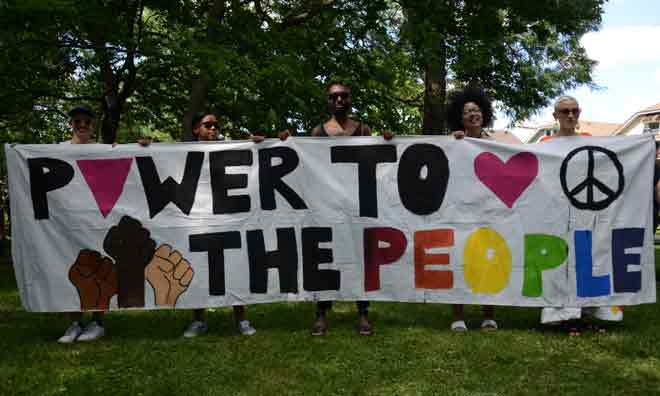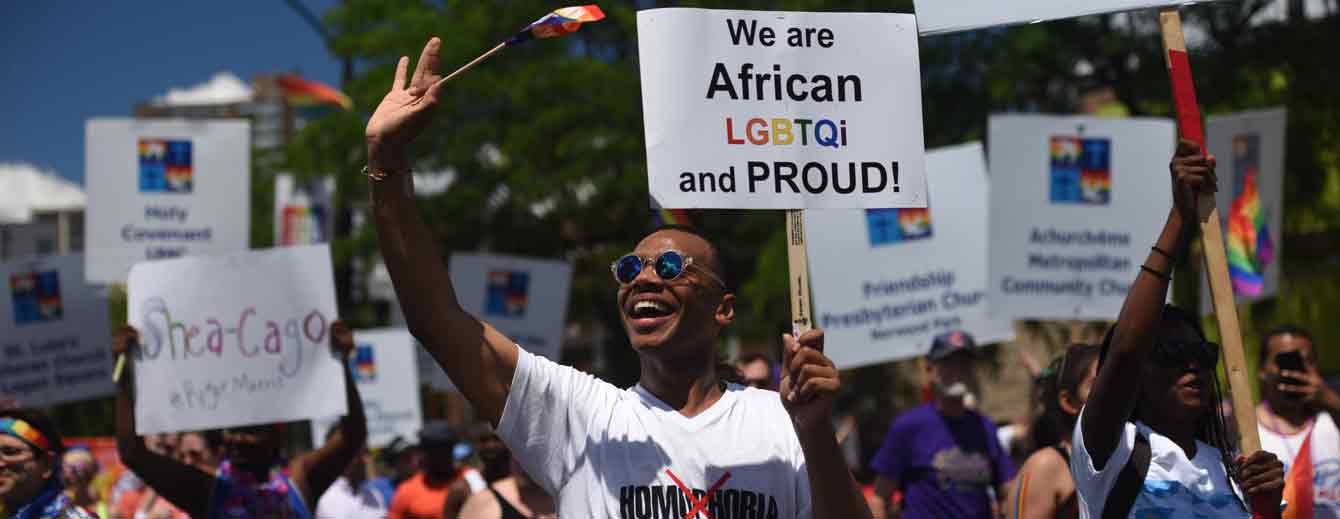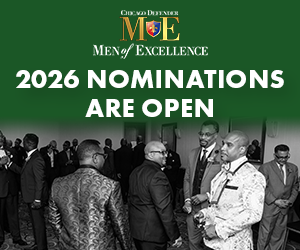Chicago Pride Parade 2015, courtesy of DNAinfo.com
[ione_embed src=https://www.youtube.com/embed/VbuVUeumKls service=youtube width=640 height=360 type=iframe]
The founders of Black Pride and Chicago Black Pride have spent decades forging a unique space for the Black queer community, which recently has come under greater scrutiny than ever before. Dating back to 1990, Black Pride has sought to provide sanctuary from the combined prejudices of cisgender African Americans (those who identify with gender they were born) and the White gay communities which, on the eve of the celebration of Chicago Black Pride 2017, has given cause to shout the the name of a 1968 James Brown hit: “I’m Black and I’m proud.”
The Black Pride Movement originated in large part in the early 1990’s in Washington, D.C., as an outlet for the Black LGBT community to socialize amongst one another in a space that celebrated being both Black and queer, according to accounts maintained by The Center for Black Equality. Cities across the nation later adopted the model. This year alone more than 30 Black Pride events have been scheduled from March to November in cities spanning the United States and in the countries of Jamaica, South Africa, France, and the United Kingdom.
The Center for Black Equality advocates on-behalf of the Black LGBT community for equality and justice in the areas of social, health, and economic equity.
 Earl Fowlkes, president/CEO for The Center for Black Equity and chairman to Democratic National Committee’s LGBT Caucus, explained that Black Pride events create a “safe space” for attendees.
Earl Fowlkes, president/CEO for The Center for Black Equity and chairman to Democratic National Committee’s LGBT Caucus, explained that Black Pride events create a “safe space” for attendees.
“The reality is that people want safe spaces, they want spaces where they can authentically be who they are,” said Fowlkes. “We are not monolithic people so Black and queer are just parts of many of us. Black Pride is one of those places that uniquely allows you to breathe safely and it continues to grow.”
Bars traditionally were one of the primary social spheres for the queer community similar to any barber shop or hair salon for African Americans, according to Fowlkes. However, he stated, bars accepting of the Black queer community have begun to vanish across the nation. “The bar was the community center, you got your information, you got your community people in the bar and the bar is where people would go,” said Fowlkes. “Now there are fewer bars; there are fewer Black bars that cater to queer Black people. There’s a handful left in the country and because of the economics, a lot of these bars that are in the neighborhood when the [neighborhood] becomes
gentrified, the bars disappear because of economic reasons.” A quick Google search of “LGBT Bars in Chicago” revealed only two bars identify or are recognized as Black LGBT friendly bars on the South Side. The overwhelming majority of bars that identify as LGBT friendly are found within the predominantly White gay community known as “Boystown,” which is located on the city’s North Side in the Lakeview neighborhood.
Fowlkes stated bars within the White gay community have the luxury of remaining open for years while losing money all while continuously making their confines unfriendly to queer people of color. Recently, Millennials have challenged that status quo, which he said is a good thing.
Yet, without safe space, members of the Black LGBT community are uniquely vulnerable to violence and even murder as is the case for transgender women of color. For example, the Human Rights Campaign recorded at least 22 deaths of transgender women due to fatal violence, the most ever recorded, in 2016 nationwide. In Chicago, Tiara Richmond “Keke” Collier was shot and killed on February 23, 2016, according to a report by The Chicago Tribune. She was the second known transgender woman killed within a six month timespan in the city.
 Fowlkes said Black queer lives have always been undervalued similar to how Black men have always been shot by the police with the only difference between yesteryear and today is social media and videotaping. He said the rights of the Black LGBT community must be fought for and aide from other communities cannot be expected.
Fowlkes said Black queer lives have always been undervalued similar to how Black men have always been shot by the police with the only difference between yesteryear and today is social media and videotaping. He said the rights of the Black LGBT community must be fought for and aide from other communities cannot be expected.
“The White gay community is not going to do it for us, we have to do it ourselves,” said Fowlkes. “We have two jobs: we have to make queer folks understand we are going to stand up and we have to make Black folks understand that we are a part of the community and you are not just going to ignore us and take our rights away.”
Fowlkes said attempts to build bridges between the African American community have been met with tentative success. He said entities like Black churches have taken on the initiative to reach the Black LGBT community through methods like HIV/AIDS ministries among others.
“The bridges have been built,” he said. “When you build a bridge both sides have to have a good foundation to make the bridge stand.”
In Chicago, the essence of Black LGBT culture is being celebrated, defended, and archived by one of the founders of Chicago Black Pride Charles Nelson. Nelson is the founder/president/CEO of the Ubuntu Center of Chicago, which seeks to develop and implement programs, services, and build capacity for the Black single gender loving/LGBT community.
Nelson explained the mindset of the founders of Chicago Black Pride as they began hosting events in 1998 and then officially in 1999.
“In the beginning, Black Pride was more of a community effort, members of the African American LGBT community got together and said we want to have our own event to represent our culture and community,” said Nelson.
Nelson called the Ubuntu Center a “good start” toward improving Black Pride because of the increased visibility it brings and programming throughout the year. The Ubuntu Center will archive Black LGBT history, art, music along with art galleries and be a marketplace for books and films once its building officially opens.
While the idea for the Ubuntu Center was in its gestation phase, Nelson learned navigating Chicago’s gay community came with challenges. He said in his twenties he was among a wave of people who moved to the North Side of Chicago in search of a more accepting community only to learn that was not the case upon arrival. He said based on his experience with the White gay community, African Americans are either oversexualized or invisible, but they are always Black before anything.
“There’s a lot of racial tension because still what you’re seen as before you are seen as a gay man or woman or part of the LGBT community, you are still seen as a Black person,” said Nelson.
Nelson said the true colors of the White gay community are on display during the organization of Pride events. He said the African American LGBT community has always had to be its own community.
“They don’t really recruit or ask members of the African American community to be part of the effort,” said Nelson. “They expect for [African Americans] just to come but they don’t make it very welcoming so if you’re not aggressive enough or you’re not part of that North Side community where you live and function every day, you’re not very present.”
Non-African American members of the LGBT community have differing thoughts on both the relevance and necessity for celebrating Black Pride. Two such opinions were expressed at Chicago Dyke March 2017, which kicked-off at the Little Village Elementary School, 2620 S. Lawndale Ave., on June 24 – the 21st installment of the annual event. Mayadet Patitucci Cruz, one of the core organizers for Chicago Dyke March, said the March celebrates the existence and resistance of all queer and trans people of color through a volunteer and grassroots method. She explained it’s important to recognize all people of color and celebrate their Pride events both locally and nationally.
“We love the idea of separate Prides, we love that there is a Boricua (Chicago’s Puerto Rican) parade, we love that there’s Black Pride, we want all peoples to celebrate themselves in a safe environment that’s not centered in or around White folks or corporations like Pride,” said Cruz, who has organized with Chicago Dyke March for the past five years. “We love the idea of Black Pride and want it to happen, we want to know how we can continue that to happen. We want all people to feel safe and validated and celebrated here.”
Cruz said in the past she has not felt wanted or included in Boystown and noted too that queer and trans people of color are highly policed and incarcerated in Boystown. She said Chicago Dyke March, which travels to different Chicago neighborhoods each year, has no interest in returning to Boystown or Andersonville after hosting events there for 11 years. In years past, Dyke March has been in Pilsen, South Shore, Humboldt Park, among others.
However, one Chicago Dyke March attendee viewed the celebration of Black Pride as divisive. Joe Lusignan, who was attending his first March opted to go this year with his choir, Windy City Travel Choir, said he “does not like to look at color”.
“I think when you have it all separate you’re supporting division as opposed when you do it all together you’re actually showing inclusion,” said Lusignan. “When you can see a march that has men, women, trans, Black, White, Hispanic, Muslim, veterans, when you see it all together and everyone is marching together there is your diversity.”
The Edgewater resident said bringing everyone together makes for a “much broader statement” in terms of both politically and in life in general.




